
Many of you might’ve already heard about Zalipie, a small village in southern Poland where an old custom still survives nowadays: houses are decorated in rich flowery patterns both on the inside and outside. Today I want to describe a short history of that custom for you, and also to show a few examples of similar decorative folk art in the other regions of Poland from the past. Painting the interiors of cottages – and in rarer cases the exteriors as well – is an old tradition known from many rural regions of the Eastern and Central European countries, including Poland. In a lot of documented historical cases from around 100 years ago the painted patterns were rather simple in form and their meaning was connected to the forgotten protective rites.
But let’s focus on the village of Zalipie at the beginning. It’s not exactly clear when did the custom start there, or for how long was it truly practiced. A lot of sources repeat an anecdote that the custom flourished in 19th century when the local women started decorating their rooms with brighter colors after the old types of furnaces using a hole in the roof had been replaced by a modern type of stoves with a chimney. Ethnographers are sure that the tradition followed a much older custom of applying simple symbols that were no longer covered so quickly with the soot from the furnace – therefore the women could let their imagination and their artistic needs flow.
What’s sure, Zalipie was first described for its paintings only at the beginning of 20th century.
It happened thanks to a boy from Zalipie who was working in the city of Kraków for Mr. Władysław Hickel, a townsman who was greatly interested in folklore. The discovery was purely accidental: the boy once brought a colorful drawing of a tapestry from his home village and Mr. Hickel noticed the drawing. The vivid patterns inspired him to visit the boy’s village in order to learn more about the local decorative art.
The custom soon gained recognition in the city, and a lot of artists and journalists expressed their interest. The village was visited by numerous scholars who started describing the Zalipie folklore in popular ethnography magazines. The first article about the custom was released in Kraków in the magazine “Lud” in the year 1905 – and that year marks the official beginning of the history of paintings from Zalipie.

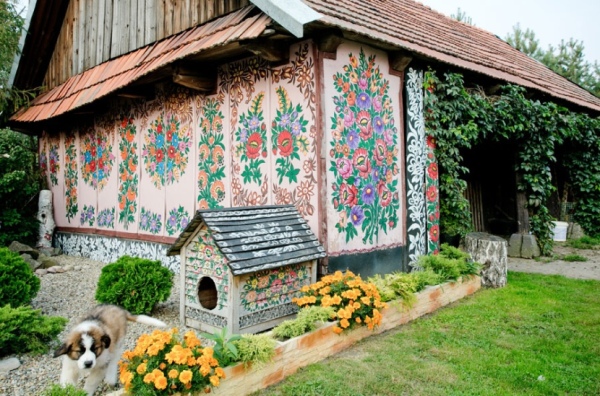

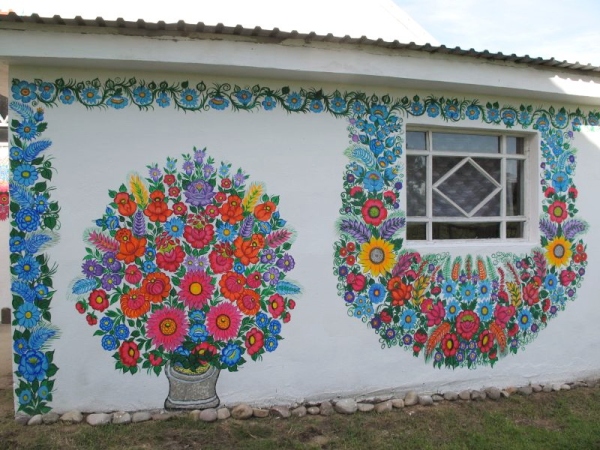




The paintings, known today under the term of ‘Zalipie style’, used to be popular among dozens of neighbouring rural districts around Zalipie in the past. Although the custom was slowly dying out due to the 20th-century industrialization, the painted decorations can be still spotted in other villages located close to Zalipie, for example Olesno, Niwki, Ćwików or Kłyż. It’s mostly thanks to an annual competition that encourages the local artists to keep the custom alive.
The competition takes place around every beginning of June, and therefore the summer months of July and August are the best to visit the region – at that time you can see the paintings in their best shape, untouched by the atmospheric impact. This year, in the first days of June 2018, it was already a 55th edition of the competition that took place. Many single houses in the neighbouring villages like those few mentioned above are taking part in it nowadays, but in the terms of authenticity the custom survived in a full continuity only in the village of Zalipie.
Zalipie gained an international recognition thanks to a passionate folk artist named Felicja Curyłowa (1904-1974), whose elaborately decorated house became a trademark of the village and of the ‘Zalipie style’ art. Nowadays her carefully preserved house is governed by a local branch of ethnography museum and it can be still visited for a small fee that helps in its maintenance.
(Side note, in case someone reading this plans to visit Zalipie this year: on the main museum’s website there’s a note that Felicja Curyłowa’s house will be closed for renovation until the end of 2018. However, the whole village and the nearby ‘Dom Malarek’ (‘House of Painters’) will be still open for visitors as usual!)

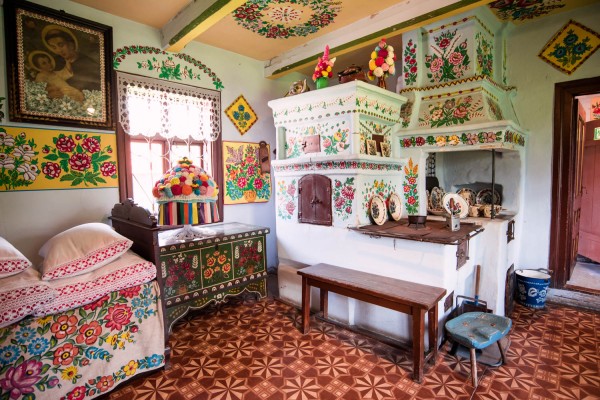

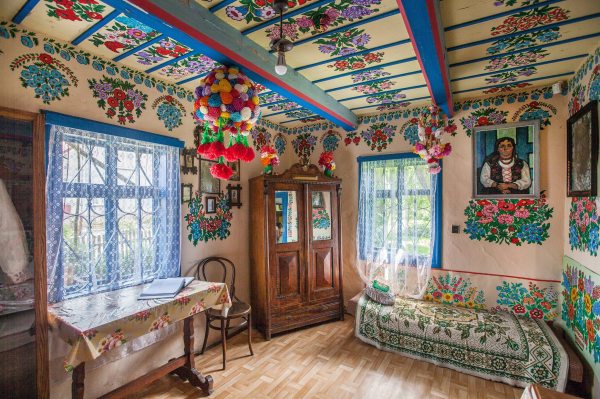
Over the recent decades Zalipie has been gaining much more international recognition, and was branded ‘the most Instagramable village in Poland’ by local authorities following a few videos made by popular youtubers. Nowadays during the summer seasons the little village is visited by tourists from various parts of the world, and since a good few years it became particularly popular among visitors from Japan who love Zalipie’s ‘cute’ vibe.
When you enter Zalipie, you can spot the vivid bouquets and garlands in various corners of the village: on the walls of both the historic cottages and the modern houses, on the barns, on the wells, on the birdhouses and the doghouses, even on small surfaces inside homes like cups, cutting boards, forks and spoons. That flowery style appears also on local folk costumes: embroidered on decorative vests and aprons.






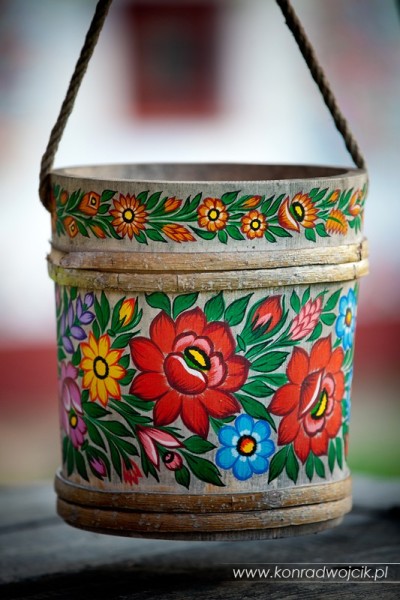


An interesting fact about the symmetrical so-called ‘bouquets’ painted in Zalipie is their origins. Although largely forgotten, this type of symmetrical motifs from Polish folk art are a colorful remnant of an old symbol of the Tree of Life. They were preserved in many ways and through different artistic methods throughout Poland. The symmetric so-called ‘bouquets’ are taking various forms and can be found all over Poland for example in embroidery (particularly on the backs of the bodices/vests worn by girls and women) or in the patterns of wycinanki (papercutting artworks) that in the old days were decorating the interiors of the houses.
Sadly, we could only guess how did Zalipie look like before its ‘discovery’ in 1905. We can however easily assume on the basis on the old articles and analogous examples from other parts of Poland that the style used to be much more minimalistic. The modern Zalipie-Style elaborate flowery patterns are now prepared purely for decorative reasons, and in this way they was greatly popularized by Mrs Felicja Curyłowa that I mentioned above.
When we look at examples from other parts of Poland, it’s becoming much more clear that what symbolism might be hidden in the ‘bouquets’.
The custom of decorating the cottages with white paints used to be relatively common in the old Polish countryside. The painted symbols tended to have a deep meaning and had usually strictly protective purposes. As such, informations about them can be found in ethnography resources from numerous other regions of Poland, varying in the various regional styles and customs. Usually, the painted cottages belonged only to the most wealthy peasants who could afford both the resources and the time to spend on the process of decorating or to hire a painter. It wasn’t always as spectacular as the explosion of colors on the walls of Zalipie, sometimes for a simple reason of the low availability of paints and their price. Before the manufactured paints became available, people used self-made mixtures based on slaked chalk and lime, tinted with natural resources (like my favourite method of using red cabbage for a blue tint) and later with store-bought pigments.
Below I’m going to show you a few examples from other parts of Poland – much more simplistic and symbolic.
Here you can see a few examples of old-style simple ‘bouquets’ from the skansens (open-air museums) in Łowicz and Maurzyce located in central Poland. Their minimalistic designs show much more clearly the connection to the Tree of Life symbolism:
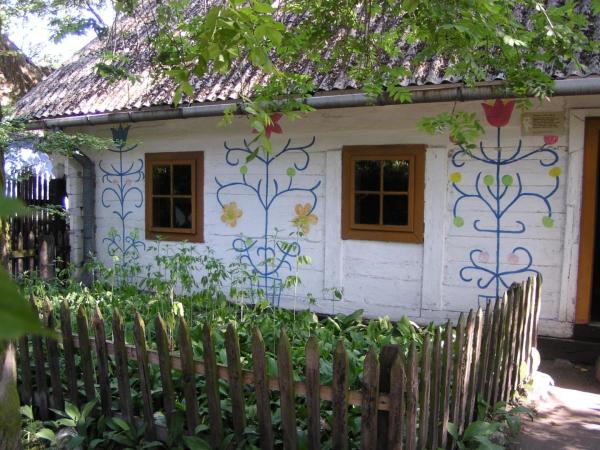
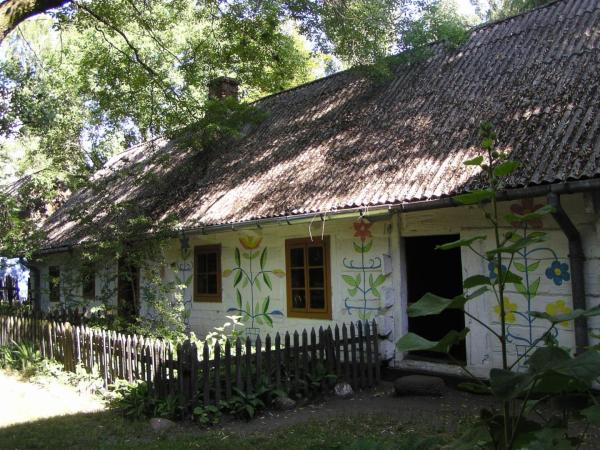

Some of the most minimalistic patterns could be seen on the cottages in the nearby skansen in Maurzyce. The paintings have to be renovated every year or two in order to keep the colors vibrant – therefore their overal look and details might differ from time to time but they are always based on authentic old preserved patterns from the region:
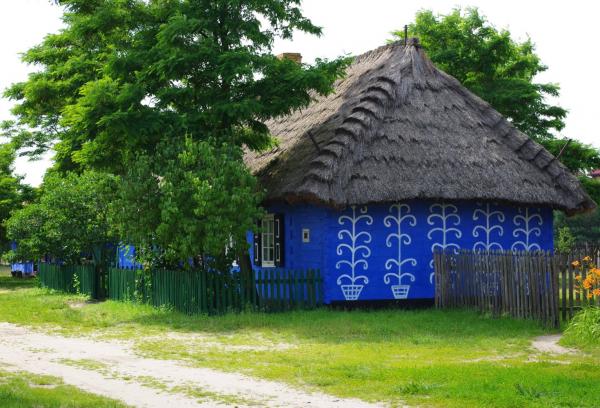

In my experience, it’s relatively easy to find written descriptions of the wall decorations but extremely hard to find old photographs showing clearly the painted walls of the cottages – but not impossible.
Here’s an example I found: rare picture of paintings from village of Łomniki near Łowicz (central Poland) included in a book “Księżacy i ich strój” released in the year 1930:

Below’s another example from the same book as above. The captions says ‘Three generations from the village of Bąków’ and is dated 1929. Behind the photographed family we can see paintings similar to those recreated in the museum nowadays:

Back to the southern Poland for a moment, here’s an example of the interior paintings inside a cottage from broadly described ‘Kraków region’, preserved in the local museum and photographed as a part of an ethography exhibition in the year 1935. It has flowery decorations similar to those from Zalipie:

Paintings on the outer walls of a cottage had been included in a model of a cottage from the village of Bronowice (nowadays a district of Kraków) made in the year 1901 by a team of artists Włodzimierz Tetmajer and Antoni Procajłowicz working with local carpenters. The model can be seen in the Seweryn Udziela’s Ethnography Museum in Kraków nowadays. You can see there a flowery arch above the doors and simple decorations on the window frames. The decorations around windows bear resemblance to a popular rural zig-zag ‘wolves teeth’ motif that ethnographers were describing as a pattern painted for protective reasons, while the smoother wavy lines resemble a popular motif for water that often meant a symbolic boost of fertility.

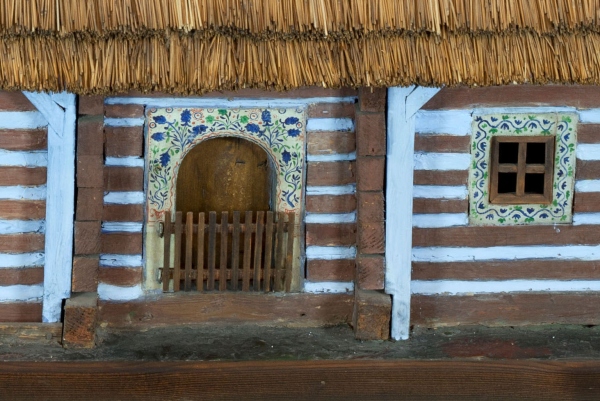

Paintings were found also in northern parts of Poland. Here’s an example of flowery walls from village of Świątkowice near Włocławek painted in 1974:

Interiors of rich peasants’ cottages had often elaborate decorations on the inside as well, like this example from Ethnography Museum in Ciechanowiec below:
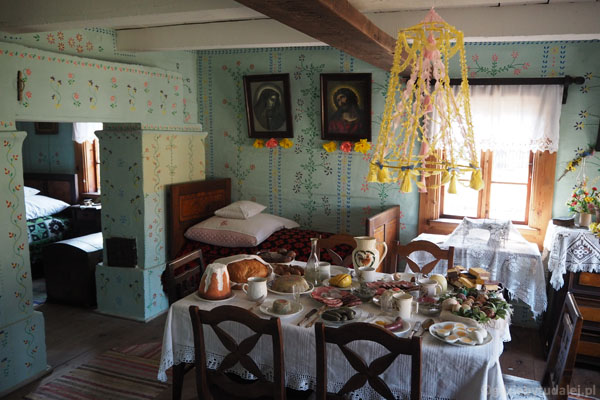

The patterns, just like in the village of Zalipie nowadays, were decorating not only the houses but also other structures around the farms. Below’s an example of beehives from the village of Mroków in Piaseczno district, central Poland:
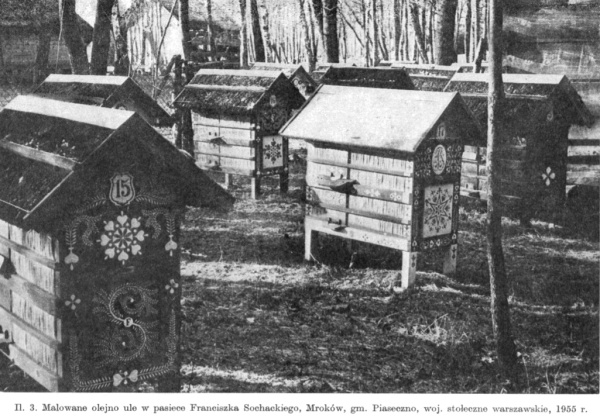
One of the sources I found during my research is an article by Polish ethnographer Roman Reinfuss, published in 1949 in the ethnography magazine “Polska Sztuka Ludowa – Konteksty” (linked at the end of this article). Below’s my compilation of some of the most interesting symbols gathered by Mr. Reinfuss, including symbols from Polish and Lemko ethnographic regions from that time.
A different symbolic method of decorating the cottages consisted of painting the entire outer walls blue, or painting just the lines of insulation between the wooden logs on the exterior – depending on the regional type of cottage’s construction. Linear decorations were painted mainly in the white or blue color, articulating the horizontal and vertical rhythms on the elevations.
Before I start describing that custom, I want to show you a few examples first. All of them are cottages recreated in various open-air ethnography museums in Poland:




And here you can see a few lovely examples of the linear decoration, where only the space between the construction logs of the wall was painted, emphasizing the structure of the walls. The colors used were blue or white:
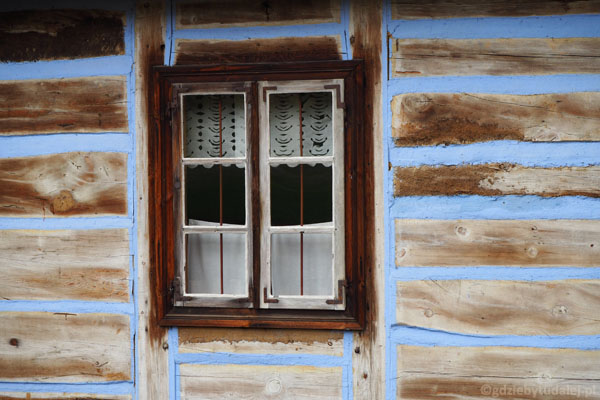


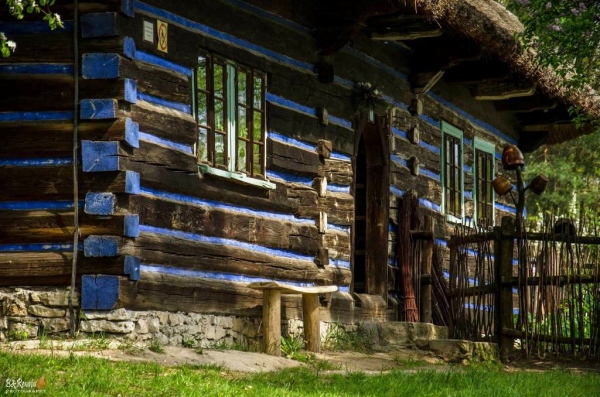
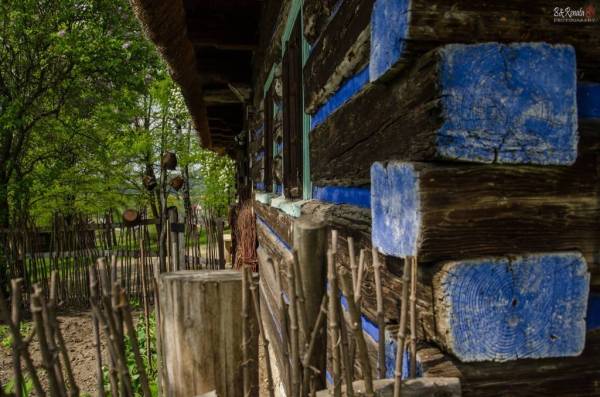
In the oldest of Polish folk traditions the color blue was representing mainly the feminine aspects of nature, and was linked to celestial symbolism, even etymologically: the word ‘niebieski’ (blue) comes from the word ‘niebo’ that means both sky and heaven, and the word ‘niebieski’ itself can mean either ‘blue’ or (rarer) ‘celestial’ depending on a context.
In some regions the blue cottages had a certain customary sign. When a girl was grown up enough to get married (a known phrase of ‘panna na wydaniu’: a marriageable girl), her family’s cottage would be deccorated in blue to let the community know that there lives a girl who’s about to come of age. In practice, it was often a sign for the local men that a ‘recruitment’ is on and the possible candidates for a husband might visit to be ‘interviewed’ by the family. That tradition was slowly fading with time, but still being kept alive in some villages in southern Poland even in the first half of 20th century.
In some regions, the color applied onto the walls had simply a protective meaning, and was linked largely to the worship of the Holy Mother who, according to Polish folklore, was always actively assisting and protecting the people. In the Polish countryside traditions the worship of her had been strongly influenced by much older beliefs in various Slavic goddesses (see examples: Holy Mother with Wolves or Holy Mother of Herbs).
Different regions were maintaining different styles that largely depended on the type of the cottages’ construction. For example, the vertical stripes of insulation between the logs was the most widespread in the villages in southern Poland that were known for constructions made of large logs, while in some areas in central Poland where cottages had the outer walls finished with smoother wooden planks, the exteriors were painted blue. In some regions only the frames around the doors and windows were painted, or only a frontal part of the cottage. In the old days the color, although not as vibrant as in the pictures above, could have been easily obtained with natural dyes like e.g. red cabbage, woad or larkspur.
The custom was slowly fading with time. In the first half of 20th century, home owners in some regions were still paintings the doors and windows blue, however for more practical reasons: the color blue had also a practical side and was believed to keep the flies and mosquitoes away from the buildings’ interiors.
The custom of painting the houses was connected to the old type of the wooden architecture, and died out first in those regions that underwent the process of morednization the fastest. Nowadays, examples of that tradition can be seen mostly in various ethnography museums, and cases of preserved private cottages that are still decorated are extremely rare.
Do poczytania po polsku (online articles in Polish):
- Roman Reinfuss: “Malowane zręby chałup wiejskich”, w: Polska Sztuka Ludowa – Konteksty, t.3 z.7-8, 1949
- Aleksander Jackowski “Współczesne malarstwo ludowe i jego pogranicza” (cz.1 ), w: Polska Sztuka Ludowa – Konteksty t.31 z.2, 1977
- “Malowana Wieś Zalipie – Zagroda Felicji Curyłowej i Dom Malarek w kolorowych kwiatach”
- Wspomnienie pośmiertne o Felicji Curyłowej [PDF]
- Zagroda Felicji Curyłowej w portalu Zabytek.pl
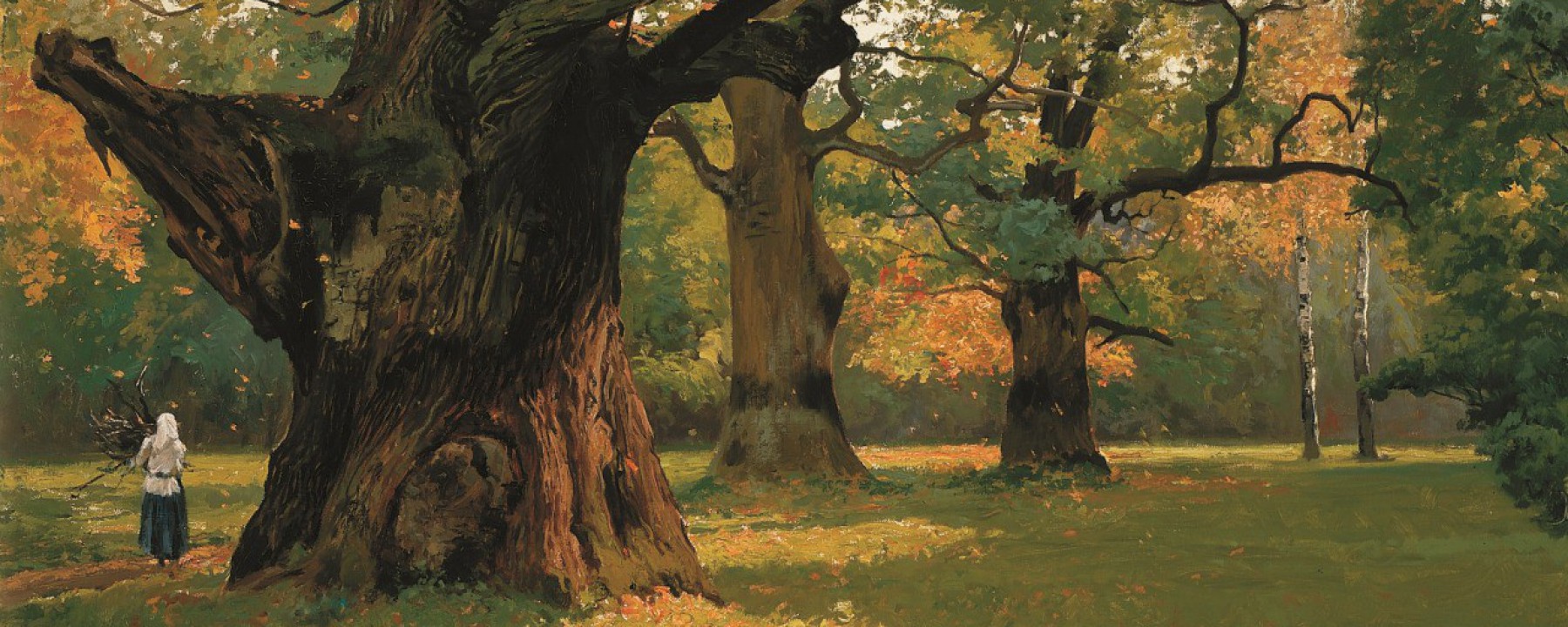

I knew nothing of the painted home, yet have decorated furniture, my doghouse, and even outside walls of my home with handpainted flowers. I was always attracted to and did embroidery. My favorite blouse was based on the embroidered white background men’s clothing. Yet I knew nothing of our family’s heritatge. My family was from Biez’dziadka, Galicia. They emigrated to the USA in 1910. I knew nothing much about it as my father did not share with his children about his parents’ lives in Poland. My cousin and his wife have done much research about our family there, having journeyed to Poland three times and have just recently shared much information with me. There is a wonderful connection for my heart here on your website and I thank you so very much. Formerly, Janet Kulig
LikeLiked by 1 person
Thank you so much for sharing your story! I hope you’ll keep finding those little connections to the roots that are still nourished in your heart. Warm greetings from Poland!
LikeLike
Bless you, your site was a beautiful gift. I keep learning……….
LikeLiked by 1 person
I’m very glad to hear that! In case you’re interested in some topic from the Polish folklore, or something I wrote is not clear (English is not my first language), always feel free to ask :)
LikeLike
Witam ! Jestem ilustratorką, która wykorzystuje w swojej sztuce, elementy wzornictwa ludowego. Jeśli znajdziesz czas, zapraszam do obejrzenia mojego portfolio: http://www.iwonaszczepanik.com/ : )
P.S. Twój blog jest dla mnie ogromnym źródłem inspiracji, dziękuję : )
LikeLiked by 1 person
Ja z kolei ogromnie dziękuję Tobie za pozostawienie śladu po wizycie i to podwójnie, ponieważ – chyba z powodu anglojęzyczności bloga – rzadko otrzymuję tutaj komentarze po polsku. Jestem zachwycona w jak ciekawy sposób wplatasz ludowe motywy w swoje prace! Przejrzałam Twoje portfolio i część bloga (doszłam do wpisu relacjonującego wizytę w muzeum Picassa i zamyśliłam się trochę nad cytatem porównującym malarza i artystę w kontekście jego twórczości). Będę wracać! A jeśli pozwolisz, chciałabym pokazać Twoje ilustracje związane z folklorem i legendami polskimi szerszemu gronu na swoim tumblrze – ale w tej sprawie jeszcze się odezwę. Pozdrawiam!
LikeLike
another great post—i always enjoy your blog!
LikeLiked by 1 person
Thank you! <3
LikeLike
Thank you once again for an interesting and informative article! My daughter and I want to do this to our shed.
LikeLiked by 1 person
That’s such a great idea to decorate a shed this way, good luck!
LikeLike
Reblogged this on The Slavic Polytheist.
LikeLiked by 1 person
Fantastic post! Thank you for sharing!
LikeLiked by 1 person
Thank you, glad you found it interesting!
LikeLiked by 1 person